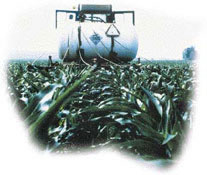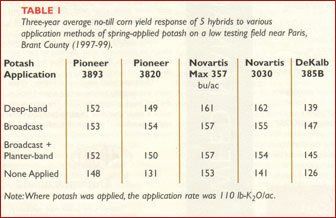
Corn Production
![]()
By Ken Janovicek, University of Guelph and Greg
Stewart, OMAFRA Corn Specialist
 low exchangeable K rating, which averaged between 50 and
60 ppm.
low exchangeable K rating, which averaged between 50 and
60 ppm.
Three methods of potash application were evaluated. Potash in the deep-band treatment was placed in a band 6" deep and corn was planted directly on top of the deep-placed band. In the broadcast + planter-band treatment, half of the potash was broadcast-applied, and the rest was applied in a 2" by 2" band at planting. The amount of potash applied was 110 lb-K2O/ac.
The 3-year average yields presented in Table
1 suggest that hybrids differed in their yield response to spring-applied
potash. The size of the yield response for two of the five hybrids (Pioneer
3893 and Novartis Max 357) was relatively small, often not exceeding 5 bu/ac.
For the three more responsive hybrids, potash usually increased yields by
15-20 bu/ac. The differences in yield response to K fertilizer were mostly
due to the ability of the non-responsive hybrids (Pioneer 3893, Novartis Max
357) to produce greater yields when K fertility levels were low.

There is also evidence that hybrids differed in their response to method of potash application. For example, the Novartis hybrids tended to produce the highest yields when potash was deep-banded, while the Dekalb hybrid tended to produce higher yields when at least part of the potash was broadcast-applied.
The differences in corn hybrid response to
K fertilization suggest that K fertility management for corn based on the
results of a single hybrid may not necessarily represent the best K fertility
management option for another hybrid. Unfortunately, it is not possible to
predict how a particular hybrid will respond to a specific K fertility management
option. Decisions for the best K fertility option for no-till corn should
be based on the results of many hybrids in order to select the management
option which has the greatest likelihood for maximizing profitability among
a wide range of hybrids.
Hybrid Response to Starter Fertilizer
Corn research work conducted in Kansas in the mid-1990s also examined the
response of a series of 5 hybrids to starter fertilizer over a three-year
period. This study was conducted on soils testing high for phosphorous, and
where fertilizer would not generally be recommended. Corn was planted early
within a no-till system and starter fertilizer (30 lb/ac N + 30 lb/ac P2O5)
was placed in a band through the corn planter (2" deep and 2" beside the corn
row). This starter treatment was compared to a 'no starter' system. For all
5 hybrids, starter fertilizer caused a significant increase in early growth.
In three of the hybrids, grain yields were significantly enhanced over the
'no starter' treatment by an average of 13 bu/ac. However, two of the hybrids
showed no yield gain.
Recommendations
Growers using side by side comparisons to fine-tune their fertility programs
are advised to be aware of the potential that not all hybrids respond as expected
to applied fertilizer. The intent of this article is not to discourage on-farm
evaluation of corn response to fertilizer application, but rather to suggest
that caution be used when interpreting yield responses that differ from those
that are expected. It may be that in some instances where unexpected results
are obtained, it is the result of a non-responsive hybrid. More reliable information
is obtained when multiple sites and multiple hybrids are used to evaluate
fertilizer options.
Acknowledgements
Research reported from the University of Guelph was conducted under the direction
of Dr. Tony Vyn. Funding for this research was provided by the Potash and
Phosphate Institute of Canada, Ontario Corn Producers' Association and Grow
Ontario.